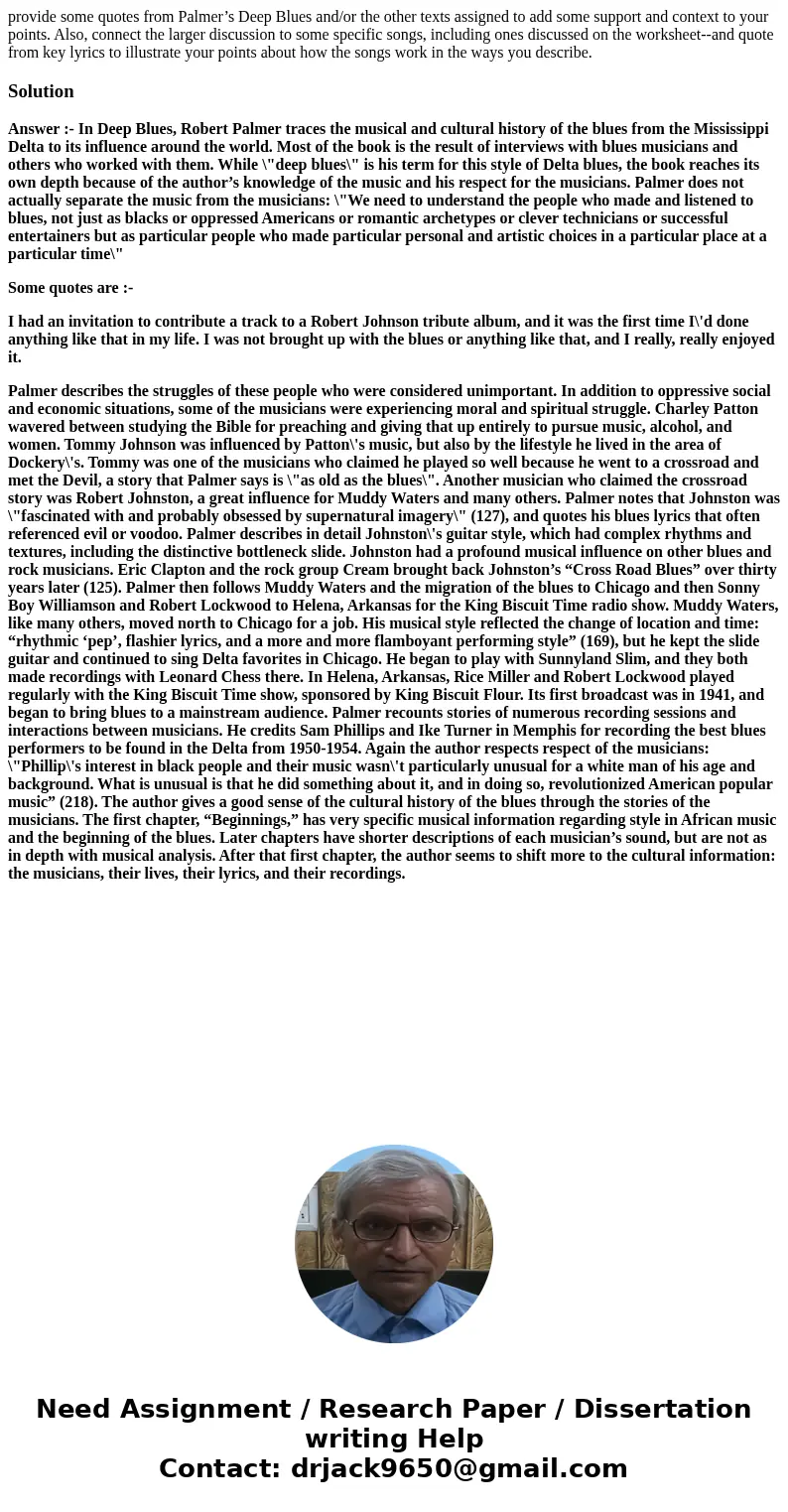provide some quotes from Palmers Deep Blues andor the other
provide some quotes from Palmer’s Deep Blues and/or the other texts assigned to add some support and context to your points. Also, connect the larger discussion to some specific songs, including ones discussed on the worksheet--and quote from key lyrics to illustrate your points about how the songs work in the ways you describe.
Solution
Answer :- In Deep Blues, Robert Palmer traces the musical and cultural history of the blues from the Mississippi Delta to its influence around the world. Most of the book is the result of interviews with blues musicians and others who worked with them. While \"deep blues\" is his term for this style of Delta blues, the book reaches its own depth because of the author’s knowledge of the music and his respect for the musicians. Palmer does not actually separate the music from the musicians: \"We need to understand the people who made and listened to blues, not just as blacks or oppressed Americans or romantic archetypes or clever technicians or successful entertainers but as particular people who made particular personal and artistic choices in a particular place at a particular time\"
Some quotes are :-
I had an invitation to contribute a track to a Robert Johnson tribute album, and it was the first time I\'d done anything like that in my life. I was not brought up with the blues or anything like that, and I really, really enjoyed it.
Palmer describes the struggles of these people who were considered unimportant. In addition to oppressive social and economic situations, some of the musicians were experiencing moral and spiritual struggle. Charley Patton wavered between studying the Bible for preaching and giving that up entirely to pursue music, alcohol, and women. Tommy Johnson was influenced by Patton\'s music, but also by the lifestyle he lived in the area of Dockery\'s. Tommy was one of the musicians who claimed he played so well because he went to a crossroad and met the Devil, a story that Palmer says is \"as old as the blues\". Another musician who claimed the crossroad story was Robert Johnston, a great influence for Muddy Waters and many others. Palmer notes that Johnston was \"fascinated with and probably obsessed by supernatural imagery\" (127), and quotes his blues lyrics that often referenced evil or voodoo. Palmer describes in detail Johnston\'s guitar style, which had complex rhythms and textures, including the distinctive bottleneck slide. Johnston had a profound musical influence on other blues and rock musicians. Eric Clapton and the rock group Cream brought back Johnston’s “Cross Road Blues” over thirty years later (125). Palmer then follows Muddy Waters and the migration of the blues to Chicago and then Sonny Boy Williamson and Robert Lockwood to Helena, Arkansas for the King Biscuit Time radio show. Muddy Waters, like many others, moved north to Chicago for a job. His musical style reflected the change of location and time: “rhythmic ‘pep’, flashier lyrics, and a more and more flamboyant performing style” (169), but he kept the slide guitar and continued to sing Delta favorites in Chicago. He began to play with Sunnyland Slim, and they both made recordings with Leonard Chess there. In Helena, Arkansas, Rice Miller and Robert Lockwood played regularly with the King Biscuit Time show, sponsored by King Biscuit Flour. Its first broadcast was in 1941, and began to bring blues to a mainstream audience. Palmer recounts stories of numerous recording sessions and interactions between musicians. He credits Sam Phillips and Ike Turner in Memphis for recording the best blues performers to be found in the Delta from 1950-1954. Again the author respects respect of the musicians: \"Phillip\'s interest in black people and their music wasn\'t particularly unusual for a white man of his age and background. What is unusual is that he did something about it, and in doing so, revolutionized American popular music” (218). The author gives a good sense of the cultural history of the blues through the stories of the musicians. The first chapter, “Beginnings,” has very specific musical information regarding style in African music and the beginning of the blues. Later chapters have shorter descriptions of each musician’s sound, but are not as in depth with musical analysis. After that first chapter, the author seems to shift more to the cultural information: the musicians, their lives, their lyrics, and their recordings.

 Homework Sourse
Homework Sourse